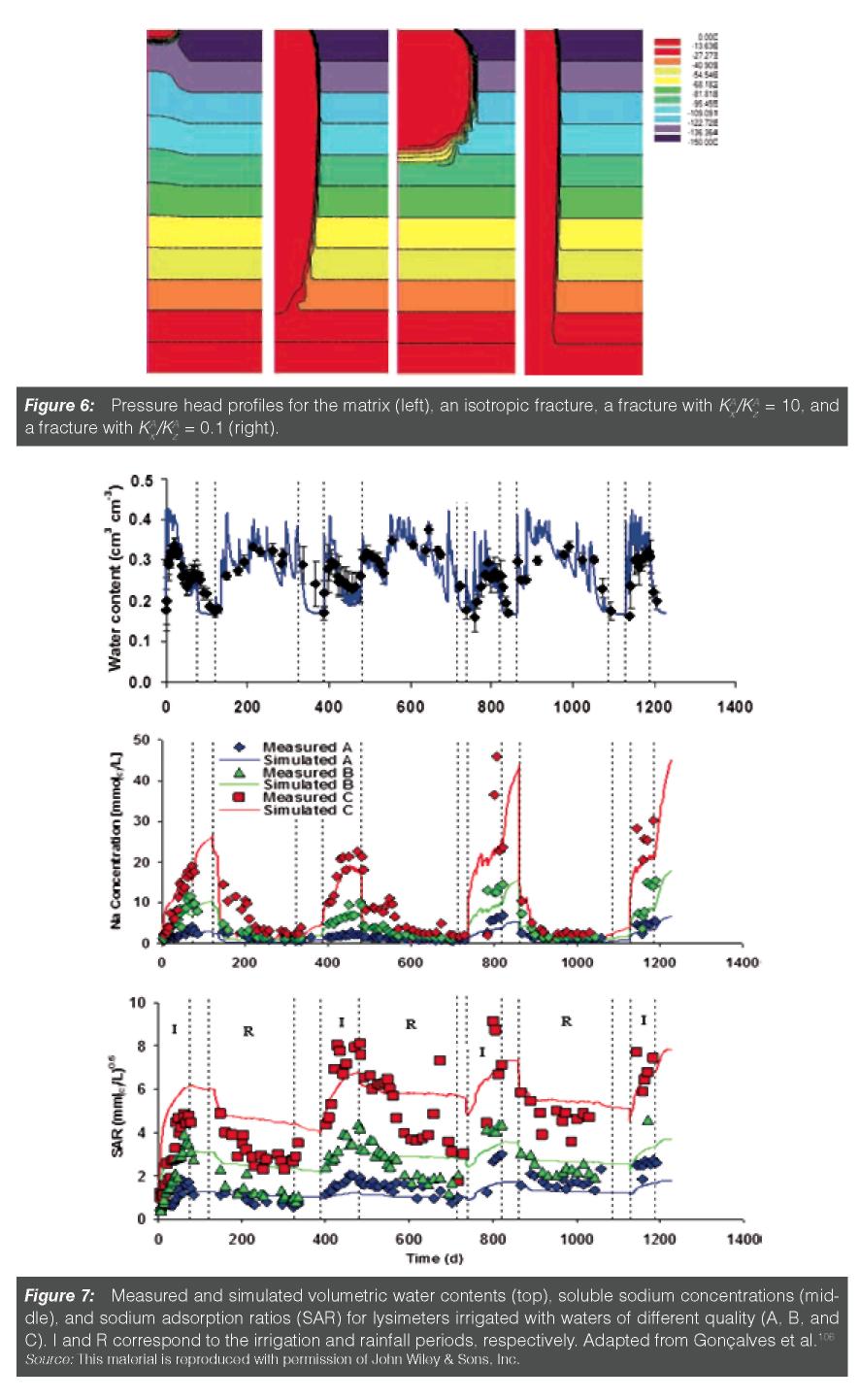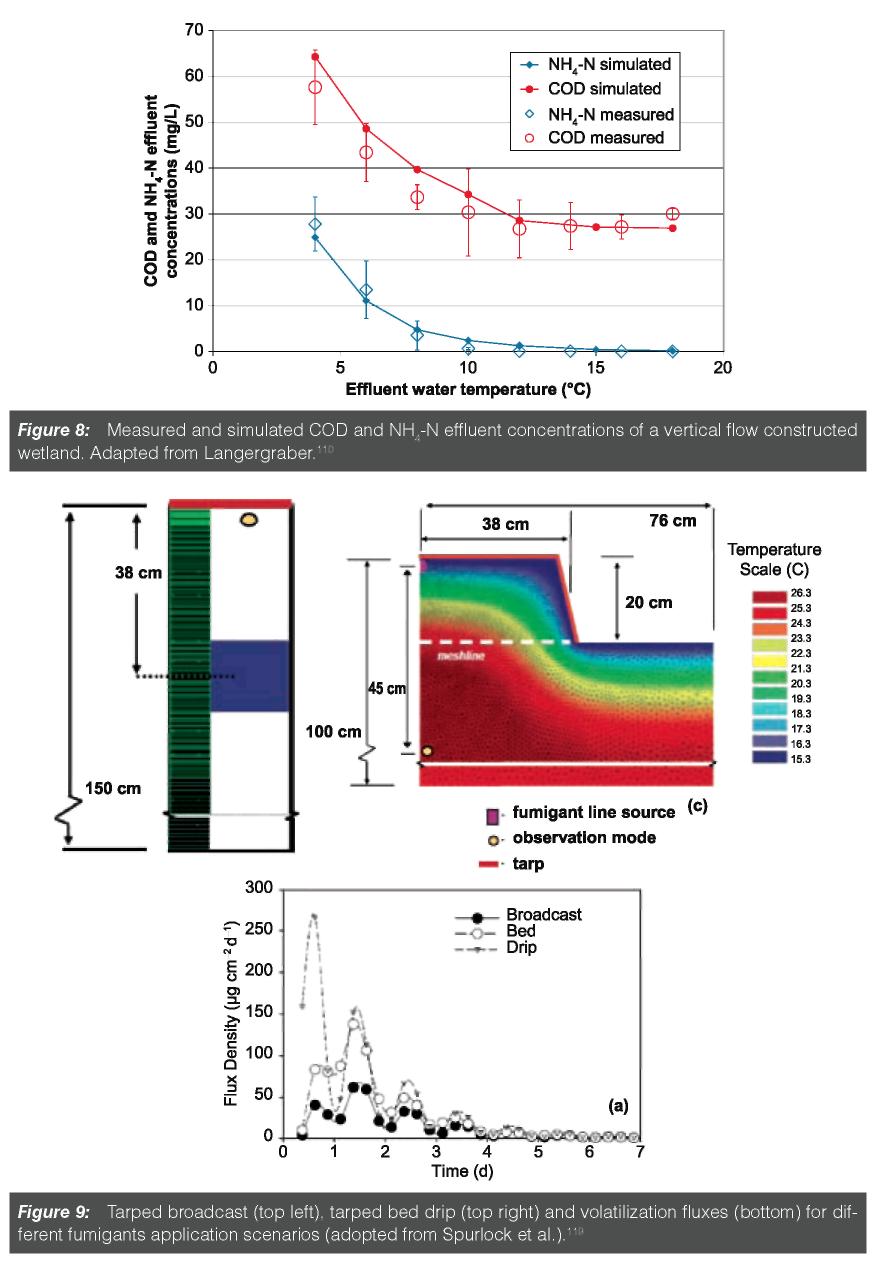
- •1 Вступ
- •2 Пакети програмного забезпечення hydrus
- •3 Переміщення розчинів
- •3.1 Переміщення поодиноких іонів
- •3.2 Transport of multiple ions subject to sequential frst-order decay reactions
- •3.3 Transport of mutually dependent multiple ions
- •4 Specialized hydrus Modules
- •4.1 The hp1/hp2 modules
- •4.3 The DualPerm module
- •4.4 The UnsatChem module
- •4.5 The Wetland module
- •4.6 The Fumigants module
- •5 Conclusions
4.3 The DualPerm module
The DualPerm module94 simulates preferential and/or nonequilibrium water fow and solute transport in dual-permeability media using the approach suggested by Gerke and van Genuchten.15 The module assumes that the porous medium consists of two interacting regions: one associated with the inter-aggregate, macropore, or fracture system, and one comprising micropores (or intra-aggregate pores) inside soil aggregates or the rock matrix. Water fow can occur in both regions, albeit at different rates. Modeling details are provided by Šimu˚nek and van Genuchten.31 The dual-permeability formulation has seen many applications, especially in 1D.95–97 Several of these examples are discussed by Köhne et al.46,47
An example of pressure head profles calculated for a tension disc infltration experiment is shown in Figure 6. The transport domain for the matrix and fracture was taken to be 50 cm wide and 150 cm deep, while the disc radium was assumed to be 10 cm. Different ratios of the anisotropy of the hydraulic conductivity were employed in the simulations (KxA/KzA = 1, 10, and 0.1 from left to right in the fgure). Various parameters used for these calculations using the DualPerm module are given by Šimu˚nek et al.94
4.4 The UnsatChem module
The UnsatChem geochemical module98 has been implemented into both the one- and two-dimensional computational versions of HYD-RUS. This module simulates the transport of major ions (i.e., Ca2+, Mg2+, Na+, K2+, SO42 -, CO32 -, and Cl-) and their equilibrium and kinetic geo-chemical interactions, such as complexation, cation exchange and precipitation-dissolution (e.g., of calcite, gypsum and/or dolomite). Possible applications include studies of the salinization/reclamation of agricultural soils, sustainability of various irrigation systems, and the disposal of brine waters from mining operations. Since the computational driver for this module was developed already some 20 years ago,69 the UnsatChem module (especially its one-dimensional version) has been used in many applications.99–105
Gonçalves et al.106 and Ramos et al.107 recently demonstrated the applicability of Unsatchem to simulating multicomponent major ion transport in soil lysimeters irrigated with waters of different quality. The UnsatChem module of HYDRUS-1D was used in their work to describe feld measurements of the water content, overall salinity, the concentration of individual soluble cations, as well as the Sodium Adsorption Ratio (SAR), Electric Conductivity (EC), and the Exchangeable Sodium Percentage (ESP). Figure 7 summarizes results for this application.


4.5 The Wetland module
The Wetland module simulates aerobic, anoxic, and anaerobic transformation and degradation processes for organic matter, nitrogen, phosphorus, and sulphur during treatment of polluted wastewater in subsurface constructed wetlands.28 Constructed wetlands are engineered water treatment systems that optimize treatment processes found in natural environments. Constructed wetlands have become popular since they can be relatively effcient in treating different types of polluted water and provide sustainable, environmentally friendly solutions. A large number of physical, chemical and biological processes are simultaneously active and may mutually infuence and stimulate each other.
The Wetland module uses two biokinetic model formulations (CW2D of Langergraber and Šimu˚nek23 and CWM1 of Langergraber et al.)108 to account for complex conditions that may occur in various types of wetlands. Both biokinetic model formulations have been developed for constructed wetlands treating municipal waste-water. A good match with measured effuent concentration data could be achieved, especially for vertical fow constructed wetlands with intermittent loadings.109–111 As an example, Figure 8 shows a comparison of simulated and measured effuent concentrations of a vertical fow constructed wetland treating municipal wastewater. In addition to applications involving municipal wastewater, the Wetland model has been also used for constructed wetlands treating combined sewer overfow,112–115 treating effuent of a wastewater treatment plant for irrigation purposes,116 and treating run-off from agricultural sites including predictions of the effects of streamside management zones.117,118
